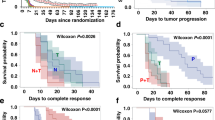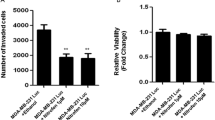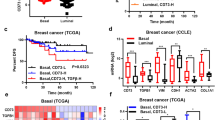Abstract
Treatments available to women with locally advanced breast cancer are unsatisfactory, since most patients succumb to metastatic spread. Therefore, there is a need to devise novel therapeutic combinations that effectively inhibit metastatization and to test them in animal models of breast cancer showing strong similarities with their human counterpart, including the ability to give rise to metastases. With these considerations in mind, tamoxifen (TAM), 4-hydrotamoxifen (4-HT) or liposome-complexed DNA constructs coding for antiangiogenic/anti-invasion proteins (angiostatin, TIMP-2, IFN-α1, sFLT-1) were individually administered to MMTVneu transgenic mice. Significant inhibition of primary tumor growth was obtained with TAM (40% inhibition, P=0.049), angiostatin (85% inhibition, P=0.001) and TIMP-2 (60% inhibition, P=0.015). No lung metastasis was observed in any of these treated mice at 5 months, compared with a rate of 70% in control groups. These observations were the basis for designing a combined treatment with all these compounds. The association of angiostatin, TIMP-2 and TAM was greatly effective at the primary tumor level (90% inhibition, P=0.01). Moreover, all the mice treated with this association were metastasis free at a time point (6 months) in which seven out of nine control mice were either dead from disseminated cancer or showed lung metastasis. This combined therapy could become an important component of anticancer therapy in humans.
This is a preview of subscription content, access via your institution
Access options
Subscribe to this journal
Receive 12 print issues and online access
$259.00 per year
only $21.58 per issue
Buy this article
- Purchase on Springer Link
- Instant access to full article PDF
Prices may be subject to local taxes which are calculated during checkout



Similar content being viewed by others
References
Rubens RD . Management of advanced breast cancer. Int J Clin Pract 2001; 55: 676–679.
Hanahan D, Folkman J . Patterns and emerging mechanisms of the angiogenic switch during tumorigenesis. Cell 1996; 86: 353–364.
Hanahan D, Christofori G, Naik P, Arbeit J . Transgenic mouse models of tumor angiogenesis: the angiogenic switch, its molecular controls, and prospects for preclinical therapeutic models. Eur J Cancer 1996; 32A: 2386–2393.
Lee JC et al. Interleukin-12 inhibits angiogenesis and growth of transplanted but not in situ mouse mammary tumor virus-induced mammary carcinomas. Cancer Res 2002; 62: 747–755.
Bergers G et al. Effects of angiogenesis inhibitors on multistage carcinogenesis in mice. Science 1999; 284: 808–812.
Sacco MG et al. Liposome-delivered angiostatin strongly inhibits tumor growth and metastatisation in a transgenic model of breast cancer. Cancer Res 2000; 60: 2660–2665.
Sacco MG et al. Local regression of breast tumors following intrammamary ganciclovir administration in double transgenic mice expressing neu oncogene and herpes simplex virus thymidine kinase. Gene Therapy 1995; 2: 493–497.
Sacco MG et al. Partial regression, yet uncomplete eradication of mammary tumors in transgenic mice by retroviral mediated HSV-TK transfer ‘in vivo’. Gene Therapy 1996; 3: 1151–1156.
Sacco MG et al. In vitro and in vivo antisense-mediated growth inhibition of a mammary adenocarcinoma from MMTV-neu transgenic mice. Gene Therapy 1998; 5: 388–393.
Sacco MG et al. Retroviral-mediated IL-4 gene therapy in spontaneous adenocarcinomas from MMTV-neu transgenic mice. Gene Therapy 1999; 6: 1893–1897.
Sacco MG et al. Systemic gene therapy with anti-angiogenic factors inhibits spontaneous breast tumor growth and metastatisation in MMTVneu transgenic mice. Gene Therapy 2001; 8: 67–70.
Sacco MG et al. Combined effects on tumor growth and metastasis by anti-estrogenic and antiangiogenic therapies in MMTV-neu mice. Gene Therapy 2002; 9: 1338–1341.
Sacco MG et al. Establishment and characterisation of a new mammary adenocarcinoma cell line derived from MMTV neu transgenic mice. Breast Cancer Res Treat 1998; 47: 171–180.
Montagna C et al. Centrosome abnormalities, recurring deletions of chromosome 4, and genomic amplification of HER2/neu define mouse mammary gland adenocarcinomas induced by mutant HER2/neu. Oncogene 2002; 21: 890–898.
O'Reilly MS, Holmgren L, Chen C, Folkman J . Angiostatin induces and sustains dormancy of human primary tumors in mice. Nat Med 1996; 2: 689–692.
Boehm T, Folkman J, Browder T, O'Reilly MS . Antiangiogenic therapy of experimental cancer does not induce acquired drug resistance. Nature 1997; 390: 404–407.
Kleiner DE, Stetler-Stevenson PG . Matrix metalloproteinases and metastasis. Cancer Chemother Pharmacol 1999; 43: 42–51.
Matrisian LM . The matrix-degrading metalloproteinases. Bioessays 1992; 14: 455–463.
Nagase H, Woessner JFJ . Matrix metalloproteinases. J Biol Chem 1999; 274: 21491–21494.
Vu TH et al. MMP-9/gelatinase B is a key regulator of growth plate angiogenesis and apoptosis of hypertrophic chondrocytes. Cell 1998; 93: 411–422.
Stetler-Stevenson WG . Matrix metalloproteinases in angiogenesis: a moving target for therapeutic intervention. J Clin Invest 1999; 103: 1237–1241.
Zhou Z et al. Impaired endochondral ossification and angiogenesis in mice deficient in membrane-type matrix metalloproteinase I. Proc Natl Acad Sci USA 2000; 97: 4052–4057.
Kong HL, Crystal RG . Gene therapy strategies for tumor antiangiogenesis. J Natl Cancer Inst 1998; 90: 273–286.
Cao Y . Endogenous angiogenesis inhibitors and their therapeutic implications. Int J Biochem Cell Biol 2001; 33: 357–369.
Goldman CK et al. Paracrine expression of a native soluble vascular endothelial growth factor receptor inhibits tumor growth, metastasis, and mortality rate. Proc Natl Acad Sci USA 1998; 95: 8795–8800.
Gutterman JU . Cytokine therapeutics: lessons from interferon alpha. Proc Natl Acad Sci USA 1994; 91: 1198–1205.
Brouty-Boye D, Zetter BR . Inhibition of cell motility by interferon. Science 1980; 208: 516–518.
Slaton JW et al. Interferon-alpha-mediated down-regulation of angiogenesis-related genes and therapy of bladder cancer are dependent on optimization of biological dose and schedule. Clin Cancer Res 1999; 5: 2726–2734.
Early Breast Cancer Collaborative Group. Tamoxifen for early breast cancer: an overview of the randomised trials. Early Breast Cancer Trialists’ Collaborative Group. Lancet 1998; 351: 1451–1467.
Custodio JB, Dinis TC, Almeida LM, Madeira VM . Tamoxifen and hydroxytamoxifen as intramembranous inhibitors of lipid peroxidation. Evidence for peroxyl radical scavenging activity. Biochem Pharmacol 1994; 47: 1989–1998.
Nguyen M, Arkell J, Jackson CJ . Human endothelial gelatinases and angiogenesis. Int J Biochem Cell Biol 2001; 33: 960–970.
McNamara DA et al. Tamoxifen inhibits endothelial cell proliferation and attenuates VEGF-mediated angiogenesis and migration in vivo. Eur J Surg Oncol 2001; 2: 714–718.
Haschek WM, Rousseaux CG . Female reproductive system. In: Fundamental of Toxicologic Pathology. Academic Press: San Diego, CA, 1998, pp 485–514.
Henderson IC et al. Comprehensive management of disseminated breast cancer. Cancer 1990; 66: 1439–1448.
Slamon DJ et al. Studies of the HER-2/neu proto-oncogene in human breast and ovarian cancer. Science 1989; 244: 707–712.
Xu X et al. Conditional mutation of Brca1 in mammary epithelial cells results in blunted ductal morphogenesis and tumour formation. Nat Genet 1999; 22: 37–43.
Spring K et al. Mice heterozygous for mutation in Atm, the gene involved in ataxia-telangiectasia, have heightened susceptibility to cancer. Nat Genet 2002; 32: 185–190.
Kerbel R, Folkman J . Clinical translation of angiogenesis of angiogenesis inhibitors. Nat Rev Cancer 2002; 2: 727–739.
Indraccolo S et al. Generation of expression plasmids for angiostatin, endostatin and TIMP-2 for cancer gene therapy. Int J Biol Markers 1999; 14: 251–256.
Indraccolo S et al. Differential effects of angiostatin, endostatin and interferon-alpha(1) gene transfer on in vivo growth of human breast cancer cells. Gene Therapy 2002; 9: 867–878.
DuBridge RB et al. Analysis of mutation in human cells by using an Epstein-Barr virus shuttle system. Mol Cell Biol 1987; 7: 379–387.
Albini A et al. The beta-core fragment of human chorionic gonadotrophin inhibits growth of Kaposi's sarcoma-derived cells and a new immortalized Kaposi's sarcoma cell line. AIDS 1997; 11: 713–721.
Gallacher S, Winston SE, Fuller SA, Hurrell JGR . Immunoblotting and immunodetection. In: Ausubel FM et al (eds). Current Protocols in Molecular Biology. John Wiley & Sons: Canada, 1994, Unit 10.8.1–10.8.17.
Cardiff RD et al. The mammary pathology of genetically engineered mice: the consensus report and recommendations from the Annapolis meeting. Oncogene 2000; 19: 968–988.
Acknowledgements
The technical assistance of L Susani is acknowledged. We thank Fulvio Adorni for statistical analysis. The financial supports of AIRC to MGS, Ministero della Salute to MGS, MIUR Genomica Funzionale to PV and MIUR-FIRB to PV (RBNE019J9W) are gratefully acknowledged. This is manuscript no. 66 of the Genoma 2000/ITBA Project funded by CARIPLO.
Author information
Authors and Affiliations
Rights and permissions
About this article
Cite this article
Sacco, M., Soldati, S., Indraccolo, S. et al. Combined antiestrogen, antiangiogenic and anti-invasion therapy inhibits primary and metastatic tumor growth in the MMTVneu model of breast cancer. Gene Ther 10, 1903–1909 (2003). https://doi.org/10.1038/sj.gt.3302082
Received:
Accepted:
Published:
Issue Date:
DOI: https://doi.org/10.1038/sj.gt.3302082
Keywords
This article is cited by
-
TIMP-2 mediates the anti-invasive effects of the nitric oxide-releasing prodrug JS-K in breast cancer cells
Breast Cancer Research (2008)
-
Effects of IL-12 gene therapy on spontaneous transgenic and transplanted breast tumors
Breast Cancer Research and Treatment (2008)
-
Extracellular Proteolysis in Transgenic Mouse Models of Breast Cancer
Journal of Mammary Gland Biology and Neoplasia (2007)
-
From genetic abnormality to metastases: murine models of breast cancer and their use in the development of anticancer therapies
Breast Cancer Research and Treatment (2006)
-
The promise of genetically engineered mice for cancer prevention studies
Nature Reviews Cancer (2005)



